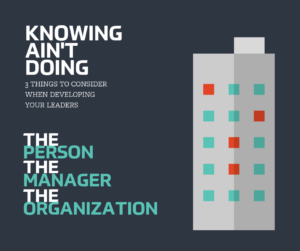3 Keys to Help Develop Your Leaders
Knowing Ain’t Doing
I know I’m supposed to eat salads and workout. I’ll have improved mental health, a trimmer waistline, less risk of certain diseases, live longer, etc. It’s not that I’m NOT aware of these benefits. After a long day, I’d rather eat a burrito and watch TV than eat a bowl of kale and plank. I KNOW what’s healthy, but it certainly doesn’t mean I will DO it.
Leadership development has a similar problem. There isn’t a shortage of content that helps people become better leaders. Organizations send leaders to a workshop and expect them to know everything about leadership and implement it when they leave. Or worse, organizations don’t provide any development for their leaders. Leaders must know what and how to do things that help them, their teams, and organizations. But it can’t stop there.

The good news is there is a way to help bridge the knowing-doing gap. It involves the leader, the manager of the leader, and the organization. Read on to dissect the role each of these play.
The Person
Most of the time, leadership teams promote those who demonstrate success as an individual contributor. Organizations must realize that while people have a history of success, the work changes when you throw managing people into the mix. This person must get results through others. The new leader benefits from learning the skills to become successful. Most of us benefit from learning things over time with chances to try them out in the “real world” and through development experiences that happen over time rather than one-day workshops aka “trainertainment.” The leader must know what and how to do things to get results through others.
The Manager
The manager of the leader plays a critical role in helping move from knowing to doing. The manager needs to play an integral part in helping develop their leaders including setting expectations, providing coaching and feedback, and allowing the person to occasionally stub their toe as they begin trying out new skills. We know that people go through an “implementation dip” when doing things differently, and the manager must help the leader get through it to become successful. The manager must engage with the employee to leverage a leadership development experience. The worst thing that happens is the leader returns from training, and the manager never has a conversation about it.
The Organization
The organization must provide a culture and structure that will move a leader from knowing how to be effective as a leader to becoming an effective leader. An organization needs to ask itself whether they are rewarding the development of leadership behaviors. Are there any consequences if the leader doesn’t demonstrate the desired leadership behaviors? Are there appropriate systems and structures in place to help the leader become most effective? Answer these questions when evaluating performance management, succession planning, culture, and core values.
– – – – –
While providing leadership development is a critical first step, it is simply not enough. An organization will get the most from its people when leaders demonstrate effective behaviors. These behaviors must be followed up with coaching and rewards before they can finally move from knowing to doing. As a colleague once told me, “knowing for the sake of knowing is a waste of time and money in a business environment.”
develop your future leaders
At ADVISA, we commend companies and leaders who are committed to helping develop their leaders! We’re also here to help along the way. If you need help maximizing the potential of your leaders, check out our leadership development courses. We offer options for everyone from emerging leaders to established leaders.
You can also read through “Talent optimization: why you should invest in leadership development” from The Predictive Index for more insights.
